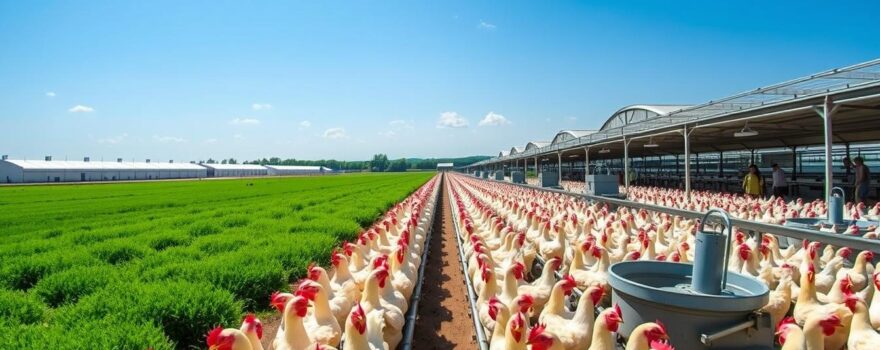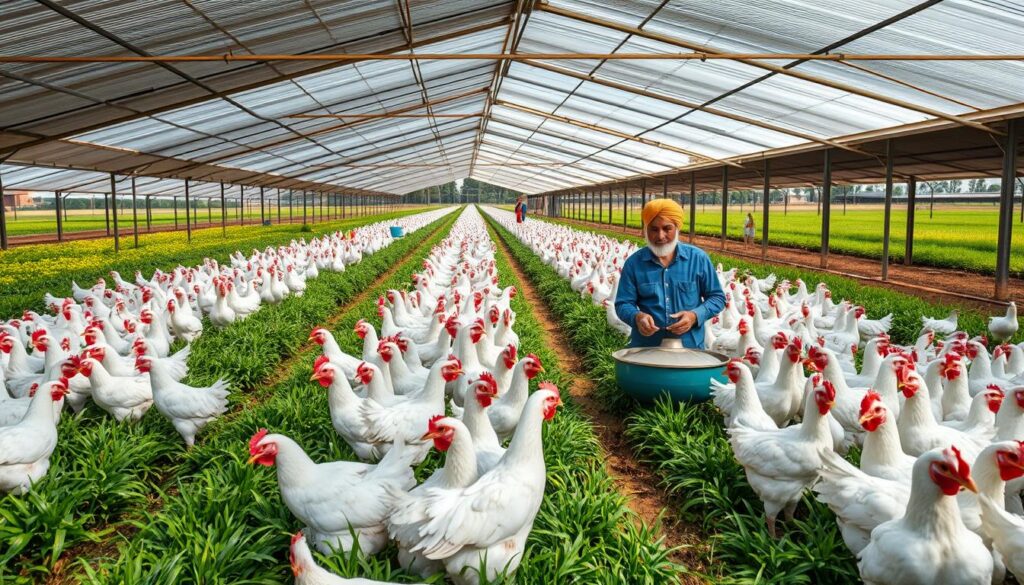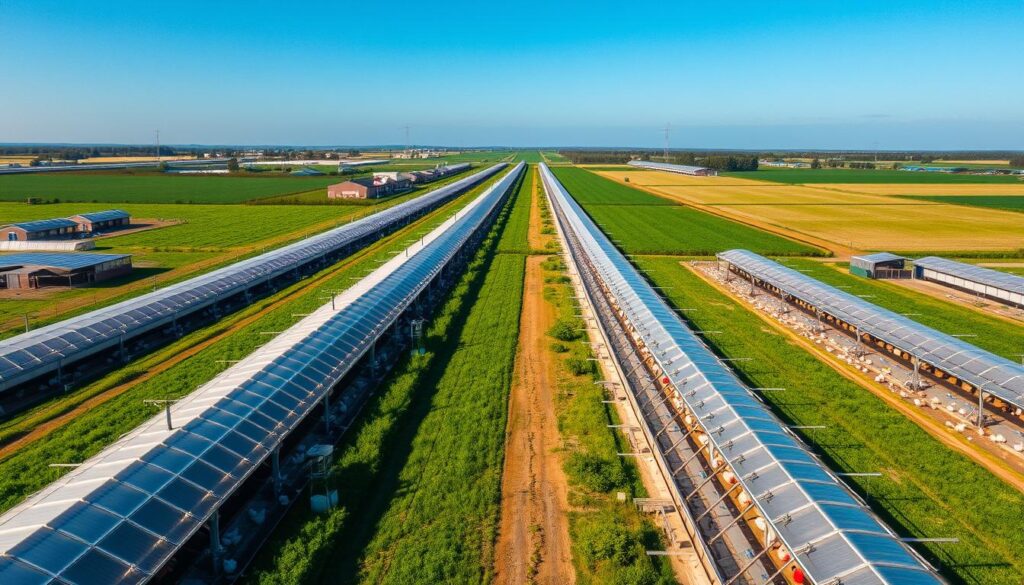
The poultry industry in the United States makes over $70 billion each year. This makes it very appealing to investors. To grow your broiler chicken farm, you need a good plan, lots of research, and smart investments. This article will cover the main points of investing in poultry farming to grow your broiler chicken operation.
Key Takeaways
- The poultry industry is a booming sector, generating over $70 billion in annual sales in the United States.
- Broiler chickens can be ready for market in as little as six to seven weeks, providing quick turnover on investments.
- Investing in infrastructure, such as solar-powered farms and efficient machinery, can significantly boost profitability.
- Diversifying revenue streams through meat production, packaging, and delivery services can enhance the overall financial stability of a poultry farm.
- Proper financial planning and access to investment capital are crucial for successfully scaling a broiler chicken farm.
The Booming Poultry Industry
The poultry industry has seen huge growth in recent years. This is because more people around the world want to eat poultry products. Poultry is now the biggest imported livestock item globally. Experts say the demand for poultry meat and eggs will keep going up until the 2030s.
Growing Demand for Poultry Products
Several things have led to more people wanting poultry. The world’s population is growing, and people are living better. They also want healthier, leaner protein sources. Poultry is seen as a cheap and versatile protein, making it popular everywhere.
Also, the poultry industry has gotten better at making products. This has made poultry more efficient and affordable.
Diversifying Poultry Operations
Poultry farmers are now offering more types of poultry products. They are introducing different bird types, like heritage breeds or specialty chickens. They also have value-added items, such as packaged meat and egg-based products.
This move helps farmers meet changing consumer tastes. It also opens up new ways for them to make money.
| Poultry Industry Growth Indicators | 2015 | 2020 | 2025 (Projected) |
|---|---|---|---|
| Global Poultry Meat Production (Million Tons) | 112.8 | 128.5 | 143.2 |
| Global Poultry Egg Production (Million Tons) | 82.1 | 92.0 | 101.5 |
| Per Capita Poultry Consumption (Kg/Year) | 13.7 | 15.2 | 16.5 |
“The poultry industry is well-positioned to capitalize on the growing global demand for protein-rich foods. By diversifying their product offerings, poultry farmers can stay ahead of the curve and meet the evolving preferences of consumers.”
What Makes a Poultry Farm Investable?
Investing in a poultry farm is a big decision that needs careful thought. You must look at several important things to make sure it’s a good investment. This includes checking if the farm can make money and grow.
Conducting Thorough Research
It’s key to do a lot of research before investing in a poultry farm. You need to know about the production process, market trends, and rules. Also, understanding the competition is vital. Look into poultry farm investment criteria, research for poultry farm investments, and analyzing poultry market demand.
Developing a Solid Business Plan
A good poultry business plan is important to attract investors. The plan should have financial forecasts, cost breakdowns, and clear goals. Investors want to see a smart plan for running and growing the farm.
Assessing Market Demand
It’s important to check how much demand there is for poultry products. Look at population growth, what consumers want, and how competitive the local market is. Knowing the poultry market demand helps investors decide if it’s a good investment.
| Key Factors for Poultry Farm Investments | Importance |
|---|---|
| Thorough Industry Research | High |
| Comprehensive Business Plan | High |
| Detailed Market Demand Analysis | High |
| Financial Projections and Cost Analysis | High |
| Experienced Management Team | Moderate |

By focusing on these key points, poultry farm owners can show their farm is a good investment. This can help attract the money needed to grow and expand the business.
Pros and Cons of Investing in Poultry Farming
Investing in poultry farming can be very profitable. The industry is growing fast and more people want poultry products. But, it’s important to know both the good and bad sides of this investment.
Advantages of Poultry Farming Investments
One big plus is the rising need for poultry products. The growth of African poultry meat production is expected to jump by 14.16% from 2015 to 2024. This shows the industry is booming and demand is up.
Also, the need for chicken meat and eggs in Africa is growing. Egg demand is expected to rise by 3.9% each year. Poultry farming offers a variety of products, like meat and eggs, which can help make more money.
Broiler chickens can be sold in just 30-45 days. This is faster than other livestock, making it a quick way to make money.
Challenges in Poultry Farming Investments
Despite the benefits, there are downsides to poultry farming investments. Market changes can affect prices and demand. The industry also has strict rules to follow, which can be costly.
Starting a big poultry farm needs a lot of money for buildings, chicks, feed, and tools. Keeping the chickens healthy is also key. This includes using closed houses and vaccinations to prevent diseases.
To succeed, you need to plan well and manage carefully. This will help you get the most out of poultry farming investments.
The Role of Investment in Scaling Your Broiler Chicken Farm
Investment is key to growing a broiler chicken farm. It helps in upgrading infrastructure, boosting production, and finding new ways to make money. This way, farms can become more profitable and grow faster. Investing in things like new equipment, better facilities, and services can help farms grow and meet market needs.
Using modern tools and tech can make farming more efficient and cheaper. For instance, machines that feed and water birds can help them grow better. Also, systems that control the climate can keep birds healthy and happy.
Adding more space for birds, processing, and storage can change a farm’s game. It lets farmers raise more birds and meet demand. Also, offering services like meat processing can bring in more money.
In short, investing wisely is crucial for a broiler chicken farm to grow. It opens up new chances for growth, makes farming better, and keeps farms competitive in the fast-changing poultry world.
| Key Factors Influencing Broiler Chicken Farm Scaling | Impact of Investment |
|---|---|
| Broiler growth rates and feed efficiency | Investments in high-quality feed, genetics, and housing can improve growth rates and feed conversion ratios, leading to higher yields. |
| Disease and mortality management | Investments in biosecurity measures, veterinary care, and disease monitoring can reduce losses and improve flock health. |
| Automation and technology | Investments in automated feeding, watering, and climate control systems can increase efficiency and reduce labor costs. |
| Facility expansion and upgrades | Investments in additional housing, processing, and storage facilities can increase production capacity and enable economies of scale. |
| Diversification of revenue streams | Investments in value-added services, such as meat processing and packaging, can diversify income sources and enhance profitability. |

“Strategic investment is the key to unlocking the full growth potential of a broiler chicken farm. By continuously enhancing their operations, poultry farmers can stay ahead of the curve and capitalize on the booming demand for poultry products.”
Investing in Poultry Farm Infrastructure
Investing in poultry farm infrastructure is key to growing your broiler chicken operation. This means upgrading your equipment and expanding your facilities. It helps increase production and offer more products.
Upgrading Machinery and Equipment
Modernizing your farm’s equipment can make operations more efficient and cut costs. Smart systems and automated feed mills can improve productivity. These upgrades prepare your farm for growth and expansion.
Expanding Facilities and Buildings
Expanding your farm’s facilities opens up new business opportunities. Adding more chicken houses or expanding processing spaces boosts production. This lets you meet demand and offer more products to customers.
Government grants can help fund these upgrades and expansions. They support poultry farm infrastructure investment. Grants help buy new equipment and improve infrastructure, boosting productivity and sustainability.
| Benefit | Description |
|---|---|
| Financial Assistance | Government grants can provide financial support for upgrading poultry farming equipment and expanding poultry farm facilities. |
| Productivity Enhancement | Grants enable investments in advanced technology and innovative practices to boost production efficiency and capacity. |
| Sustainability Promotion | Grants encourage the adoption of eco-friendly and sustainable farming practices, such as renewable energy solutions and waste management systems. |
| Technical Expertise Access | Grants often include access to expert guidance on farm management, disease prevention, and optimization strategies. |
“Investing in poultry farm infrastructure is a strategic move that can unlock new growth opportunities and strengthen the long-term viability of your broiler chicken operation.”
Enhancing Broiler Chicken Production
Scaling a poultry farm is more than just growing bigger. It’s about boosting broiler chicken production. This means focusing on bigger flocks and better breeding and hatching.
Increasing Flock Size
To grow the flock, you need more chicken houses, feeders, and other equipment. In Maryland, broiler production jumped from $426 million in 1986 to $3.21 billion in 2016. This growth shows the importance of expanding.
Integrators like big operations to save on costs. Each farm needs enough space for chicks, with costs around $10.95 per square foot for new houses.
Improving Breeding and Hatching
Improving breeding and hatching can also increase production. Pullet farms are big, with sizes from 42,000 to 72,000 square feet. Hens can lay 150 to 175 eggs in their lifetime.
Breeder houses are smaller, but still important. They range from 16,000 to 22,000 square feet. The revenue from these farms can be up to $4.60 per square foot each year.
Integrators face challenges like environmental and animal welfare issues. So, efficient breeding and hatching are key.
| Metric | Value |
|---|---|
| Broiler live weights | 3.5 to 10 pounds |
| Broiler flock lengths | 32 to 70 days from placement to catch |
| Processing plant capacity | 1 million birds weekly, requiring 300 to 400 broiler houses |
By focusing on these strategies, poultry farmers can grow and make more money. It’s all about increasing production and improving breeding and hatching.
Diversifying Revenue Streams
Broiler chicken farmers need to find new ways to make money as they grow. One smart move is investing in poultry meat production and packaging. This way, they can sell more than just live birds. They can sell meat directly to people or stores.
Another good idea is to start a poultry delivery service. This can help farmers reach more customers. It’s great for both individual buyers and local businesses.
Meat Production and Packaging
Setting up meat processing and packaging on the farm can really boost profits. It lets farmers sell their products in different ways. This appeals to more customers, from big buyers to those who want to buy directly.
Offering Delivery Services
Starting a poultry delivery service is a smart way to make more money. It lets farmers meet the growing demand for fresh, local chicken. It’s a service that customers really appreciate.
| Revenue Stream | Potential Benefits | Challenges |
|---|---|---|
| Meat Production and Packaging |
|
|
| Poultry Delivery Services |
|
|
“Diversifying revenue streams is essential for the long-term sustainability and growth of broiler chicken farms. By investing in value-added products and services, farmers can enhance their profitability and adapt to changing market demands.”
Financial Planning for Poultry Farm Expansion
Broiler chicken farmers need to plan their finances well when they want to grow. They must find the money for new infrastructure, more production, and new projects. Keeping costs down for things like feed, labor, and energy is also key to making money and keeping the farm growing.
Securing Investment Capital
Poultry farmers have many ways to get the money they need. The USDA Farm Service Agency offers loans for up to $400,000 with flexible repayment times. They also have loans for buying farms and microloans for up to $50,000. Farmers hit by disasters can get emergency loans too.
Managing Operational Costs
Keeping costs under control is vital for a poultry farm’s success. Farmers should watch their spending on feed, labor, and energy closely. By being more efficient and cutting waste, they can stay profitable. They can also make more money by offering delivery or selling value-added meat products.